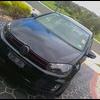Chasers? JZX100...
Announcements
-
Latest Posts
-
By joshuaho96 · Posted
You're not wrong but 5W30 at 100C is like 10 cSt vs 25 cSt for 10W60. If we think in terms of viscosity margin 10W60 will probably still be ok at 130C but 5W30 is probably too little. It's absolutely shocking how hot the oil gets in something like a stock FL5 from only ~3 minutes of use on the Nordschleife. I would not risk taking a car like that to anything remotely intense without a ton of work done for cooling. Heat shielding on the manifold/turbo/downpipe, oil coolers, etc. -
I think the concept is highlighting the various scenarios where thicker oil helps, and thicker oil potentially doesn't help and only generates heat and costs power, in turn for safety which isn't actually any safer (unless you're going real hot). If anything this does highlight why throwing Castrol 10w-60 for your track days is always a solid, safe bet.
-
Jason should have shown a real viscosity vs temp chart. All the grades have very little viscosity difference at full operating temperature.
-
Oops... I meant to include the connector view... BR/W - power from fuse L/W - motor negative to fan control amp (and off to HVAC pin19) OR/B - PWM signal (from HVAC pin20) B -- ground
-
By Murray_Calavera · Posted
Yep, if you are applying filler it sounds like there is something wrong with the body lol. Safe to assume there is going to be a lot of sanding going on if your still applying fillers. Picture a perfect bare metal panel, smooth as glass. You lay down your primer, it's perfect. (why are you going to sand it?) You lay down the colour and clear, it's perfect. No sanding at all took place and you've got a perfectly finished panel. You won't be chasing your tail, sounds like you were prepping to start laying filler. If your happy with the body after the sanding, there is some bare metal exposed and some areas with primer, no issues at all, start laying the filler. You are safe to lay filler on bare metal or primer (of course check your technical data sheet as usual for what your filler is happy to adhere to). This isn't a 100% correct statement. There is primer that is happy to adhere to smooth bare metal. There are fillers that are happy to adhere to smooth bare metal. Just make sure you're using the right materials for the job. Typically if you are using filler, you would go primer, colour and clear. I've never seen any instances before where someone has laid colour over body filler (maybe this happens, but I haven't seen it before). So your plan sounds pretty normal to me.
-



Recommended Posts
Create an account or sign in to comment
You need to be a member in order to leave a comment
Create an account
Sign up for a new account in our community. It's easy!
Register a new accountSign in
Already have an account? Sign in here.
Sign In Now